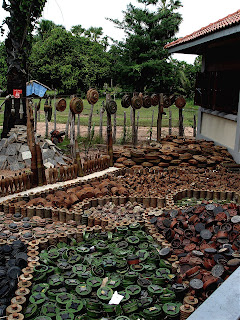
The United Nations has a program developed called "UN Works" which explores the struggles of children.
Meet Suk Ratha, Mon Man, and Laurence Fishburne who tell the story of landmines in Cambodia. You can also watch them on "What's Going On?", a 10-part TV series on Showtime that looks at kids with big problems, or Watch a clip here!
UNICEF has designated Cambodia the third most landmined country in the world, attributing over 60,000 civilian deaths and thousands more maimed or injured since 1970 to the unexploded land mines left behind in rural areas. That represents an average of nearly forty victims a week for a period of twenty years. The majority of the victims are children herding animals or playing in the fields. Adults that survive landmines often require amputation of one or more limbs and have to resort to begging for survival. In 2006, the number of landmine casualties in Cambodia took a sharp decrease of more than 50% compared to 2005, with the number of landmine victims down from 800 in 2005 to less than 400 in 2006. The reduced casualty rate continued in 2007, with 208 casualties (38 killed and 170 injured). Often areas that could be used for agriculture, commercial, civil and other uses are not accessible due to the dangers of land mines.

While the Khmer Rouge were the worst offenders, deliberately targeting the civilian population with mines and booby traps, all sides have shown blatant disregard for the long-term consequences of the use of mines. Furthermore, the blame extends beyond the warring factions. Their patrons... the Chinese, the Soviets, the Americans, and a host of smaller nations... continued to supply the weapons with callous indifference to the effects of their actions. The CMAC reports that mines found in Cambodia have been manufactured in the US, China, Vietnam, the former USSR and East Germany, the former Czechoslovakia, India, Chile, South and North Korea, Thailand, Iran, Iraq, South Africa, Bulgaria, the former Yugoslavia, Hungary, and Poland.
It is estimated that there may still be up to six million land mines scattered around the Cambodian countryside which cause approximately 35 deaths a month. Already 40,000 people have lost limbs due to land mines giving Cambodia the unenviable record of having the most amputees per capita (about one in every 275 people have lost a limb).

As well as the direct human cost of of these mines there are many other less obvious costs such as food shortages which may result from the inability to farm large areas of rural land that has been mined. At a family level the loss of livestock due to explosions can be devastating.
If you are ever in Cambodia, highly suggest a visit to the Landmine Museum. Originally founded in 1997 by former Khmer Rouge child soldier Aki Ra, the Cambodia Landmine Museum is located just outside Siem Reap near the famous temples of Angkor Wat. He created the museum under shanty styled huts to house his collection of decommissioned mines, bombs, and other explosive remnants of war (ERW) that he had cleared throughout the country since 1995.
During the late 1990’s Aki Ra continued to clear mines using the training he learned while working as a UN de-miner in 1994. After the UN left Cambodia, Aki Ra continued to clear mines on his own, slowly adding to the collection at his museum. By 2000 the museum had become a highlight destination for thousands of visitors to Cambodia. Journalists, photographers and other international documentarians began to spread the word about the museum around the world.

In March 2001 the Cambodia Landmine Museum Relief Fund in Canada was asked by Aki Ra to help create and manage an official NGO for the museum. The CLMMRF’s mission was to help maximize Aki Ra’s landmine relief initiatives at the museum while providing the project with fiscal transparency and accountability.
In 2003 the CLMMRF partnered with Dr. Julie Rogers and her team of students from Texas A&M University’s College of Architecture. The team created designs for a modern museum and relief facility that includes a dormitory residence for disadvantaged children, a feeding station, an educational facility, an administrative office, and a home for Aki Ra’s family.

The newly constructed Cambodia Landmine Museum & Relief Facility opened its doors to the public on April 22nd, 2007. The Cambodia Landmine Museum is the first licensed and accredited museum of its kind in the world. It is 100% safe and meets all protocols regarding the Ottawa International Treaty to Ban Landmines as well as the standards of the Cambodian Mine Action & Victim Assistance Authority (CMAA).
Between 2004 and 2007 the CLMMRF also worked diligently to provide Aki Ra with accredited international de-mining training and Explosive Ordnance Disposal (EOD) certification at the International School for Security and Explosives Education (ISSEE) in Salisbury, UK. These series of certifications have helped Aki Ra to create his own demining team. CAMBODIA SELF HELP DEMINING (CSHD) became a licensed NGO in Cambodia in 2008.

An amateur (yet insightful) video on de-mining may be viewed HERE.
